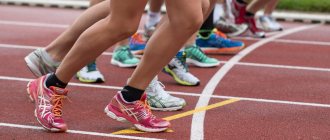Hi everybody! I’ll start by saying that I’ve been practicing 3-kilometer running for a long time, and finally I started to see improvements in running a three-kilometer distance after a long period of inactivity at one result. Moreover, a couple of months ago it seemed to me that I would be able to improve the result no sooner than in a year. And about the fact that I will improve my running time by 40 seconds in 2 months... At that moment, when I ran to the finish line with a feeling of full effort, thinking that if I improve my result by even 5 seconds, then I will certainly vomit. And after two months, I improve my results significantly and at the finish line I understand that I can run even faster. And to improve the results, it turned out that you just needed to change your approach to training.
What they write about on the Internet about running 3 km
Not understanding my downtime on one result, I resorted to the help of the Internet. There was more than enough information on this topic, but it felt as if these articles were written from the same template. All approaches to the 3 km run were described in the same way. And one got the impression that they were often described by people who either did not run for results, or who ran at all a couple of times, and then only during physical education at school. And most of the text was written to order on the article exchange, where any student or girl on maternity leave received an order on this topic as a freelancer.
I don’t want to offend anyone, since I still got the basis from these articles. And some bloggers described their results and techniques as very useful. By applying the techniques that I read, the result improved, but not much. Perhaps more time was needed.
Still inclined to think about shifting his paradigm. Very simple things that need to be felt once rather than heard a hundred times. And perhaps in their articles these people (precisely those who describe their experience in running) feel this and at the same time find it difficult to convey through text.
general characteristics
Athletes who competed at 1500 meters usually test their strength at 3000 meters. The further path of athletes depends on their goals and strengths. Some people spend their entire career specializing in middle distances - from 800 to 3000 meters; for others, 3000 meters is the starting point for development in long running disciplines.
It is no coincidence that the distance of 3000 meters is considered borderline between medium and long. The average speed developed by elite athletes at 3000 m is closer to the speed of stayers than to the speed of average athletes. Basically it's 2:30-2:35 min/km. For comparison: the average speed of elite athletes at a distance of 1500 meters is 2:20 min/km (with a result of 3:30), and the average speed of elite athletes at 5000 meters is in the range of 2:35-2:40.
An important advantage that the 3000-meter distance gives to stayers is the opportunity to improve their speed qualities.
Many famous marathon runners - Kenenisa Bekele, Eliud Kipchoge, Haile Gebrselassie - have gone from 3000-5000 meters to the marathon. The speed that an athlete gains over shorter distances helps them run half marathons and marathons quickly and more calmly.
Breathing while running
Breathing should occur with full chest and belly. Who else doesn’t know what it is to breathe with your stomach? I'm telling you. Pay attention to how we breathe. At this moment, the chest expands. If, while breathing, you concentrate your attention on the work of the lower abdomen, and expand it when inhaling, then with such breathing, the organs and muscles will receive more oxygen, thereby becoming less tired. If you want to learn more about the technique and benefits of belly breathing, I advise you to scour the Internet. And we return to the topic of improving results in 3 km runs.
At first, this method seemed very inconvenient to me. First, running tightens your abs, making it difficult to expand. Secondly, there is a constant feeling as if you are breathing incorrectly. After a couple of runs, this feeling will go away.
And one more moment. Two steps for inhalation, two for exhalation. It keeps the rhythm great. Try to breathe through both your mouth and nose. I repeat, the more oxygen supplied to the muscles, the less tired they will be.
Running technique
The technique is simple... While running, the body should be relaxed, slightly tilted forward. Look in front of you, do not turn your head to the sides. The arms move straight forward to the jawline and back at a 90° angle, without crossing in front of the chest.
How to place your foot when running
There are also various techniques for placing the foot, both from heel to toe, and vice versa, from toe to heel. More experienced runners often use the toe-to-heel technique. This technique requires strong calf muscles, but the efficiency is higher than other techniques, which is perfect for a distance of 3 km.
The heel-to-toe running technique is more common, especially among beginner runners, but there are marathon champions with this technique. If the foot is positioned incorrectly, there is a higher risk of injury.
I use a heel-to-toe technique, but over time I move to a toe-to-heel technique. Later, I somehow came across the book “Running by the 80/20 Rule”. It devotes an entire chapter to running technique, where it is recommended not to pay special attention to how to place your foot when running or swing your arms. Because of this, I had a small “conflict in my head”... How is this possible?... Everyone writes about the correct technique, but it turns out there is none. More precisely, it is achieved not by controlling leg placement and arm swing, but by running volumes at low intensity.
In short... based on the interpretation of this book, the brain should stop controlling the running technique, and do it intuitively or rather reflexively. In this way, the maximum reduction in energy consumption is achieved. Run easily!!!
General physical training
In order to run 3000 meters , in addition to endurance, you must also have strong leg muscles, so you must do a set of physical exercises to strengthen your hips, feet, and calf muscles.
Such exercises include: jumping rope, step-up squats, pistol squats (squats on one leg), jumping jacks and many others.
You definitely need to pump up your abs, which is very important for running.
General physical exercises can be alternated with running exercises, or you can devote a certain period of time only to them. But two weeks before the competition, general physical training must be stopped completely.
Exercises to improve results
Bottom and middle. The bottom, as you may have guessed, is the legs. It is advisable to do strength exercises. Barbell squats, lunges. The middle is the link between the bottom and the top. Strong middle, strong body. Therefore, pumping the press cannot be neglected.
Result: Improved endurance and speed by an average of 5-10 seconds.
Let me remind you that these improvements came after I “hit the wall.” There was such a feeling of not understanding how anyone could run faster. It comes after about a couple of years of regular training. When downtime on the spot drags on and the opposite effect begins.
Race tactics
Athletes start from a general start, so after the starting shot it is important to take a comfortable position. For some it is more convenient to lead the race, for others it is easier to control the race from the middle of the group.
marathon and half marathon training plans and start training today!
After the starting acceleration, the athletes pick up the speed at which they will run the entire race, with the exception of the finishing acceleration. This speed is developed during tempo training.
For convenience, the distance can be divided by kilometer. The forces need to be calculated in such a way that the last kilometer is faster than the rest. After the second kilometer, the speed increases slightly, and 400 meters before the finish, acceleration begins, which can be excellently worked on in interval training.
How to learn to run fast: 7 tips for beginners
The Basics of 3K Running from My Own Experience
As I talked about in the previous article “How to record sports training” about the need to record your results for more effective training, this is perhaps the fundamental basis.
After running, goals appear for the result. Goals force you to improve. If you haven't gotten to this point yet... it's just a matter of time. Now you will most likely not take this fact as seriously as your breathing work, exercises and running technique, but I assure you that you will get a much greater surge of energy and motivation. And without motivation, not a single exercise or technique will affect the result.
Power training
We've decided on the motivation. The next jump as a result occurred after adjusting the strength training. This advice came from a healthy guy from the gym where I work out. His advice always helped me, for which I am always grateful.
The essence of the advice is simple. My leg strength training ended with pumping my calf muscles. I now start my training with this exercise. The number of approaches doubled. I am constantly increasing the load. After a few workouts, my performance with barbell squats improved, which improved my overall leg health.
And finally, the most effective moments, which had the greatest impact on improving the result in the 3 km run. Treadmill or running with an opponent many times superior to you. If you combine this, the result will be already in the next workout. And a significant result.
General recommendations
Losing excess weight
Often people usually think that with the help of running exercises the extra pounds will “melt off”. Of course this is true. But you also need to remember that excess weight can create a very large load on the body, primarily on the joints and the cardiovascular system.
Therefore, before starting active training and preparing for passing standards or serious competitions, you need to try to get rid of fat deposits as much as possible. First of all, following a proper diet, working out in the gym, and walking will help you with this.
Strengthening the cardiovascular system
A runner must strengthen his heart, because without a strong heart you cannot build endurance. You can strengthen your cardiovascular system, for example, through cardio training.
Among other things, they will help you understand how best to use your own strength and how to learn to run three kilometers in a short time.
Exercises on various machines are suitable for such cardio training:
If you are not a big fan of the gym, then exercise equipment can be replaced by walking, cycling, skiing, boating, or kayaking.
Swimming will also provide excellent results in terms of strengthening the cardiovascular system. In general, you need to move as much as possible and lead an active lifestyle.
Correct breathing
Running can only be effective if you have the correct breathing technique. Sometimes it allows you to simply complete the distance, not to mention achieving high results.
How to eat properly?
It is extremely important to take care of your diet. Before training, you need to “feed” the body with proteins and carbohydrates in a ratio of 1 to 3. Also, before jogging, you should give up fiber and fat to avoid stomach problems.
Here are nutrition tips:
- Two hours before your run, you can have a snack of fruit and a couple of peanut butter sandwiches.
- An hour before training, you can drink a glass of orange juice plus something light that contains protein.
- If there are a few minutes left before your workout, eat a handful of nuts, dates - they contain glucose,
After training, within 30 minutes you should eat food containing proteins and carbohydrates in the following proportion: 1 to 4 or 5. You can also eat carbohydrates.
Getting rid of bad habits
It is highly recommended to quit smoking. This bad habit is incompatible with running. Only by getting rid of this bad habit can one claim to achieve certain results in sports, in this case, covering a three-kilometer distance in a certain period of time.
Endurance development
There are several effective exercises for developing endurance:
- Running in conditions of slight elevation, approximately 5-8 degrees. You should take up to thirty steps within twenty seconds. You should run uphill for at least twenty minutes.
- You can alternate running on flat terrain with running uphill. For example, 40 minutes on a flat path and 20 minutes uphill.
Tips for running three kilometers
Here are the following rules and tips for training to overcome a three-kilometer distance:
- You need to start by running short distances at a calm rhythm.
- Training should be done at a convenient time, it doesn’t matter - in the morning or in the evening.
- You can't be lazy and skip workouts.
- It’s better to run with a player, downloading your favorite music into it.
- Pay special attention to choosing high-quality running clothes and shoes.
Running with an opponent superior to you
Running with an opponent is the best thing ever. If you have such a friend, you are lucky. I had a friend like this. For the first time, halfway through the 3 km distance, I was blown away. His superiority over me was significant. That's the whole point. The spirit of competition, the will to win, forces a weak body to develop precisely at such moments.
No runners you know...? At the stadium there is an opportunity to ask someone to go for a run together. Don’t choose to be weaker than yourself, it will only make you worse. The only one stopping you from achieving results is yourself. Train your will.
Result: Improved endurance and speed by an average of 40-60 seconds.
ATTENTION: If you have a coach, you don’t have to read this article.
PHASE IV[edit | edit code]
The final quality phase of an intensive distance program is set up to combine your strengths, previous training results and competitive experience. The key components of this phase should be adequate rest and recovery from exercise, quality training (to a limited extent), carefully selected competitions and perhaps some reduction in weekly mileage. The hardest physical work has been completed, and its result should be an increase in performance and results. Do not increase training loads during this phase. Simply perform quality exercises with minimal effort and build up energy for important and interesting races.
Still plan for two quality training days (T1 and T2) before the competition on Saturday (which should also count as a quality session). But if competition is especially important to you, limit your quality workouts to one day this week—skip the quality exercise that produces the most stress. It is advisable to schedule the remaining quality session for Tuesday. For a 6-week plan, there are four options for organizing quality days in preparation for the competition on Saturday:
- Monday-Wednesday (standard approach);
- Tuesday-Wednesday (provides an opportunity to better recover from the competitions of the previous week);
- Monday-Tuesday (option to add an extra easy day before the competition on Saturday when the previous week's competition requires minor recovery);
- Tuesday as the only quality day (when the competition on Saturday is of particular importance).
Finish your races on Sunday with a series of easy, fast 200m runs. The 200-meter segments run on easy days should never be a sprint. Their fastest pace is the 800 meter race pace. After each segment, adequate recovery must occur. Be especially careful not to increase or decrease the intensity of your training in the final weeks of the season. The best approach is to reduce the load, that is, reduce the amount of work, but not the speed.
There's no doubt that some middle-distance runners rely on endurance more than others, and this is where being able to understand your responses to different types of training (or having a coach who can do this for you) can make a big difference. It is for this reason that it takes many years to develop to full potential at these distances. You spend several seasons developing one aspect of your talent and then spend several seasons realizing that you took the wrong approach. Every runner must constantly experiment to find the right mix of components for their training.
By the way
In the era of advanced technologies, convenient and affordable heart rate monitors appear. With their help, you can track your heart rate while running, thereby keeping your pace within your capabilities. Next year I plan to purchase such a thing. Once I test it, I’ll definitely write a post on the topic of running with heart rate monitoring. (already bought, tested and wrote my review in the article here) Anyone who already uses this thing, please briefly describe the benefits in the comments.
conclusions
In conclusion, we can say that the above methods for improving 3 km running results were achieved through trial and error. Practice, practice and more practice. We've set a goal, go ahead. Don't stop there, improve. Self-discipline is for great people, and you can, no, you should be one of them.
Addition: after several years of practice, I wrote a post “How to run 3 km in 12 minutes,” where I shared my personal experience about running. In it, I revised some of my positions regarding the approach to training.
I ask all runners to write their criticism in the comments. I also ask you to post your methods for developing endurance and speed, preferably for a 3 km running distance.
That's all, create yourself with CSelf.ru! Sincerely, Alexander Petrishchev!
For intermediate level
Have you reached your goal and are wondering how to run 3 km faster? To achieve a result of 13 minutes, you need to work more on endurance and increase your mileage:
- I – 7000 m, pace – above average;
- II – 1000 m. Three cycles, break – 60 seconds;
- III – eight times 500 m each, alternating with a minute walk.
Do you want to, but don’t know how to improve the score to 12? Start exercising four times a week, increase the intensity of interval training:
- I – 7000 meters;
- II – one thousand, four cycles with 40 seconds. rest between them;
- III – 500 m, repeat 6 times with a break of 40 seconds. fast walking;
- IV – 3 approaches of a thousand. Between them, do 30 squats.
There is no limit to perfection. Do you feel that 3 km in 11 minutes is within your reach? Get to work! Train 5 times, interval approaches are even more intense:
- I – track – 5000 meters. At the finish line, immediately do a plank with push-ups 50 times: squat down, place your palms on the floor in front of you. Jump your legs back, take a position as for push-ups from the floor. Do one push-up and return to the starting squat position;
- II – one thousand, we do three cycles with 40 squats between;
- III – alternate 8 times: 400 m run – 10 times plank with push-ups;
- IV – 6 sets of 500, walk quickly for 40 seconds during the break;
- three times a thousand, between them – 40 seconds of walking.











